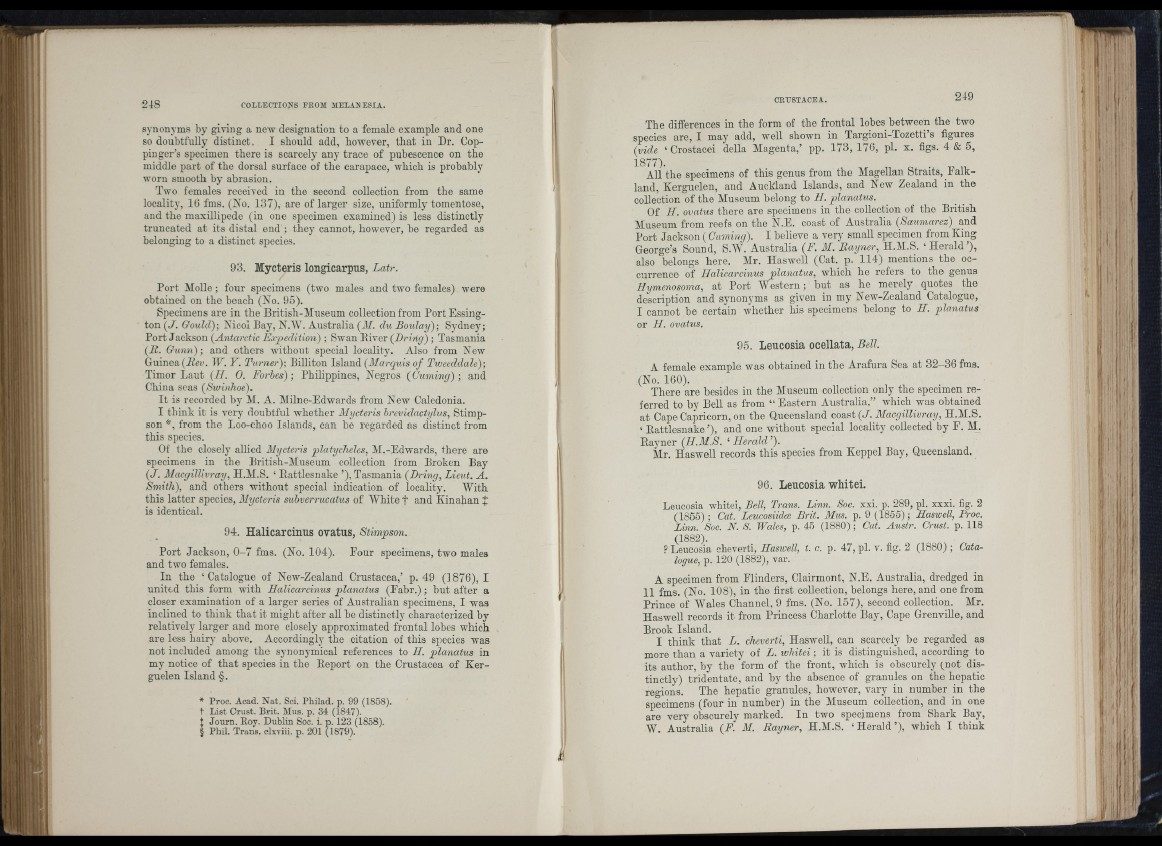
I
li
i t
synonyms by giving a new designation to a female example and one
so doubtfully distinct. I should add, however, th at in Dr. Coppinger’s
specimen there is scarcely any trace of pubescence on the
middle part of the dorsal surface of the carapace, which is probably
worn smooth by abrasion.
Two females received in the second collection from the same
locality, 16 fms. (No. 137), are of larger size, uniformly tomentose,
and the maxillipede (in one specimen examined) is less distinctly
truncated at its distal end ; they cannot, however, be regarded as
belonging to a distinct species.
93. Mycteris longicarpus, Latr.
Port Molle ; four specimens (two males and two females) were
obtained on the beach (No. 95).
Specimens are in tho British-Museum collection from Port Essington
{J. Gould); Nicol Bay, N.AV. Australia (AI. du Boiday); Sydney;
Port Jackson (Antarctic Expedition) ; Swan River (Driiig) ; Tasmania
(B. Gunn); and others without special locality. Also from New
Guinea (Rev. W. Y. Turner)-. Billiton Island (Alarquis o f Tweeddale);
Timor Laut (H. 0. Forhes); Philippines, Negros (Cuming); and
China seas (Swinhoe).
I t is recorded by AI. A. Alilne-Edwards from New Caledonia.
I think it is very doubtful whether Alycteris hrevidactylvs, Stimpson
*, from the Loo-choo Islands, can he regarded as distinct from
this species.
Of the closely allied Alycteris platycheles, Al.-Edwards, there are
specimens in the Rritish-AInsenm collection I'rom Broken Bay
(J. Alacgillivray, H.M.S. ‘ Rattlesnake ’), Tasmania (Dring, Lieut. A .
Smith), and others without special indication of locality. AVith
this latter species, Alycteris subverrucatus of AVhite f and Kinahan %
is identical.
94. Halicarcinus ovatus, Stimpson.
Port Jackson, 0 -7 fms. (No. 104). Eour specimens, two males
and two females.
In the ‘ Catalogue of New-Zealand Crustacea,’ p. 49 (1876), I
united this form with Halicarcinus planatus (Eab r.); hut after a
closer examination of a larger series of Australian specimens, I was
inclined to think th at it might after all he distinctly characterized by
relatively larger and more closely approximated frontal lobes which
are less hairy above. Accordingly the citation of this species was
not included among the synonymical references to II. planatus in
my notice of th at species in the Report on the Crustacea of Kerguelen
Island §.
* Proc. Acad. Nat. Sci. Philad. p. 99 (1858).
t List Crust. Brit. Mus. p. 34 (1847).
I Journ^Roy. Dublin Soc. i. pp.. 1iz2;3 (1858).
§ Pbil. Trans, clxviii. p. 201 (1879).
I
; 1
i
The differences in the form of the frontal lobes between the two
species are, I may add, well shown in Targioni-Tozetti’s figures
(vide ‘ Crostacei deUa Alagenta,’ pp. 173, 176, pi. x. figs. 4 & 5,
AR the specimens of this genus from the Magellan Straits, Falkland,
Kerguelen, and Auckland Islands, and New Zealand in the
collection of the Aluseum belong to H. planatus.
Of H. ovatus there are specimens in the collection of tho British
Aluseum from reefs on the N.E. coast of Australia (Saumarez) and
Port Jackson (GamLit/). I believe a very small specimen from King
George’s Sound, S.AV. Australia (F. AI. Bayner, H.Al.S. ‘ Herald ’),
also belongs here. Air. Haswell (Cat. p. 114) mentions the occurrence
of Halicarcinus planatus, which he refers to the genus
Hymenosoma, at Port AVestern; hut as he merely quotes the
description and synonyms as given in my New-Zealand Catalogue,
I cannot be certain whether his specimens belong to H. planatus
or H. ovatus.
95. Leucosia ocellata, Bell.
A female example was obtained in the Arafura Sea at 32—36 fms.
(No. 160).
There are besides in the Aluseum collection only the specimen referred
to by Bell as from “ Eastern Australia,” which w"as obtained
a t Cape Capricorn, on the Queensland coast (J. Alacgillivray, H.Al.S.
‘ Rattlesnake’), and one without special locality collected by E. M.
Rayner (H.Al.S. ‘ Herald’).
Mr. Haswell records this species from Keppel Bay, Queensland.
96. Leucosia whitei.
Leucosia whitei, Bell, Trans. Linn. Soc. xxi. p. 289, pi. xxxi. fig. 2
(1865) ; Cat. Leucosiidce Brit. Mus. p. 9 (1855) ; Haswell, Proc.
Linn. Soc. N. S. Wales, p. 45 (1880); Cat. Austr. Crust, p. 118
(1882).
P Leucosia cheverti, Haswell, t. c. p. 47, pi. v. fig. 2 (1880) ; Catalogue,
p. 120 (1882), var.
A specimen from Flinders, Clairmont, N.E. Australia, dredged in
11 fms. (No. 108), in the first collection, belongs here, and one from
Prince of AVales Channel, 9 fms. (No. 157), second collection. Mr.
Haswell records it from Princess Charlotte Bay, Cape Grenville, and
Brook Island.
I think th at L. cheverti, HasweU, can scarcely he regarded as
more than a variety of L. whitei ; it is distinguished, according to
its author, by the form of the front, which is obscurely (not distinctly)
tridentate, and by the absence of grannies on the hepatic
regions. The hepatic granules, however, vary in number in the
specimens (four in number) in the Museum collection, and in one
are very obscurely marked. In two specimens from Shark Bay,
AV. Australia (F. M. Rayner, H.M.S. ‘H e ra ld ’), which I think
•» -i
<! I
: 11
I I
1 i‘
'ii: ,i